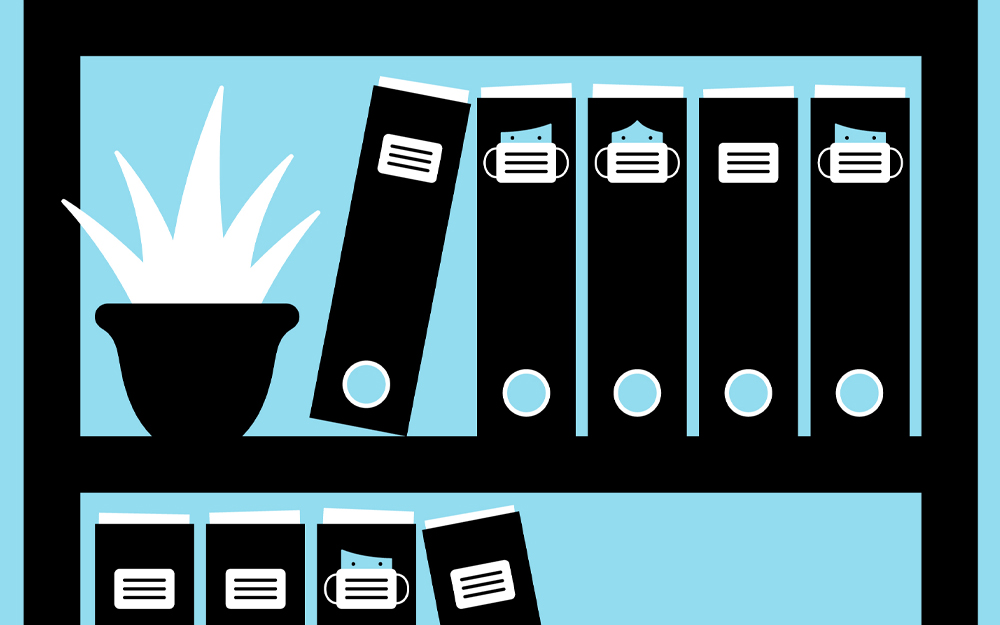Discoveries
Inside Cedars-Sinai’s COVID-19 Response
Jul 22, 2024 Cassie Tomlin

Illustration: Giulio Bonasera
In February 2020, anticipating a shortage in COVID-19 test kits that would be crucial to safely maintaining care, Cedars-Sinai began to develop in-house viral testing.
Within three weeks, the medical center had built a Level II bio safety lab, a “massive effort” that usually takes half a year, and negotiated with partners abroad to secure a validated PCR test kit, said David Frishberg, MD, Chair of Pathology and Laboratory Medicine.
Case volume in Los Angeles was low, so the lab lacked positive samples on which to validate the RNA extraction test. One night, Frishberg caught a cable news interview with the director of a molecular lab in a region with a higher caseload, and he emailed the interviewee to request positive COVID-19 samples. The reply came five minutes after the segment ended, and soon the lab received five much-needed samples, which sped up operationalization. By March 23, the Cedars-Sinai team was ready to test perioperative patients, which enabled the medical center to resume surgeries more quickly than any hospital in the region.
Frishberg’s recollection is among one of 46 candid oral histories collected for Archiving COVID-19 at Cedars-Sinai, a project documenting the health system’s pandemic experience.
The story encapsulates themes resonant throughout the collection: the significance of expanded communication and collaboration, flexibility and ingenuity, said Rena Selya, PhD, archivist at Cedars-Sinai’s Historical Conservancy.
Selya assembled over 4,100 items in the digital and physical repository, which memorializes the enormous effort of staff involved with planning and patient care and traces how evolving knowledge altered the medical center’s approach to the virus and the pandemic.
“We have a very fine-grained body of evidence about how everything changed during that time,” Selya said. “If we ultimately want to understand the long-term impact of the pandemic, being able to trace those changes is important.”
The Power of a Team
Peter Chen, MD, a pulmonary critical care physician, and research coordinators Susan Jackman and Antonina Caudill, spoke of leading a first-in-human monoclonal antibody trial.
In 2019, Chen primarily conducted basic science on influenza-mediated lung injury. But in early March he cared for his first confirmed COVID-19 patient, marking the start of a “very, very painful” period in which intensive care unit teams were stretched “five times beyond our means,” he said in his 2021 oral history interview.
That month, he led early and influential trials, leveraging his lab for the challenging process of collecting and processing COVID-19 samples.
“Usually, you'd have a centralized lab that would handle processing, but we literally processed the samples in my lab—I personally processed a lot of blood on nights and weekends, and the research coordinators were here even after I was,” he said.
Chen’s best lessons learned: Prioritize open communication above and below you, and put a structure in place.
“Having a team and understanding you can’t do this by yourself—those are the main things you can do to prepare for something like this,” he said.
"Having a team and understanding you can’t do this by yourself—those are the main things you can do to prepare for something like this."
Communicating With Community
The archive also details the health system’s COVID-19 vaccination campaigns. In an interview, Linda Burnes Bolton, DrPH, RN, said decades of partnerships in Los Angeles communities, plus its diverse nursing staff, helped built trust with the vaccine hesitant.
“Having one-on-one conversations is still a successful way of getting more people to take the vaccine,” said Burnes Bolton, who in 2020 acted as chief health equity officer. “So, we had to do our homework. We had to get back out there in the community to tell folks, ‘We care about you, and we want you to be treated well.’”
A Universal Effort
In building the archive, Selya prioritized a diversity of perspectives—each shaped by professional and social roles and marked by feelings such as fear, grief and pride.
“Each of these experiences are relevant, and I approached the archive from as many angles as possible,” she said. “It’s going to be a while before we fully understand the impact the pandemic had on American society, because it did not happen in a vacuum. The more information we have, the better.”
Mostly, the material tells a cohesive story of a shared sense of responsibility and duty to patients, co-workers and the community, she said.
“I was so impressed with everyone’s willingness to be helpful in the crisis,” Selya said. “It speaks well for the culture at Cedars-Sinai: People here are well-trained experts dedicated to their fields, and the sense of obligation to the organization really pulled everyone together.”


